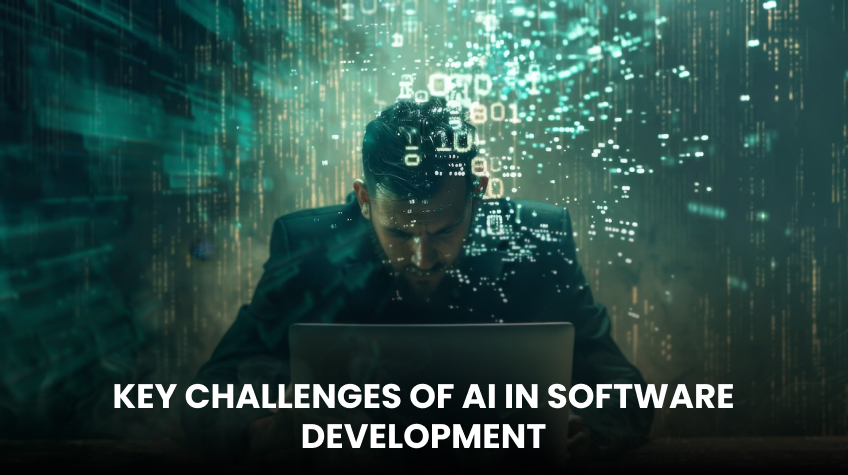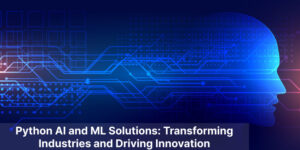
AI plays a vital role in shaping the current software development paradigms by automating the workflow, making it more efficient, and opening up new ways of performing data analysis. However, it comes with certain drawbacks when it comes to its implementation. With the growth in the adoption of AI technologies for development, new hurdles emerge such as data quality, how to interpret the models, bias, and compatibility with other systems come up as key barriers. This evidence shows that there are challenges that should be addressed to realize AI’s full potential.
Understanding the unique challenges and implementing appropriate solutions is essential to harness the full power of AI to create innovative and high-quality software. To facilitate adoption and produce more dependable AI results, this article examines the main challenges in AI-driven software development and provides solutions. Continue reading.
Key Challenges of AI in Software Development and Their Solutions
As stated, Artificial intelligence (AI) has revolutionized various sectors, but its integration into software development involves some challenges. Here are some of the key obstacles and potential solutions that a software development company India must take into account.
1. Data Quality and Availability
Data quality and availability is a prerequisite for AI models to produce accurate results.
Challenge: AI models depend much on qualitative, diverse, and sufficiently large datasets for training. Lack of quality or quantity data results in wrong predictions and unrealistic end products.
Solutions:
- Data curation: Engage in cleaning of data, labeling, and augmentation to enhance the efficiency of the outcome.
- Data generation: Use synthetic datasets along with real-life data sets where possible to incorporate synthetic data generation.
- Data partnerships: Engage other organizations to obtain different datasets and promote accuracy while incorporating AI models in software development.
2. Model Interpretability and Explainability
Challenge: The decisions made on many human-AI interfaces, especially the deep learning models, are hard to explain and this makes such models be referred to as ‘black boxes’. This is not especially good in several cases, including those where there has to be a reasonable disclosure of the intermediary.
Solutions:
- Combine Techniques: It is important to use two or more of the techniques simultaneously in order to get a better insight into the model. For instance, feature importance along with saliency maps entail the possibility of obtaining information from a global as well as from a local perspective.
- Tailored Techniques: Applications of SVM ( Support Vector Machine) need to learn methods for the given application area or domain. For example, in medical imaging, it is possible to develop methods that will help enhance particular anatomical structures.
3. Bais in AI Models
AI models may produce discriminatory results by reinforcing preexisting biases in the training data.
Challenge: Bias in AI models is a problem area and it is getting more complicated over time. It happens when an AI system acts biased and discriminative and produces output that discriminates against a particular group most likely emanating from the training data. These consequences are fatal across different facets of life including job, health, and justice systems.
Solutions:
- Diverse datasets: Use different and balanced data sets as much as possible to obtain the least biased data.
- Bias detection: Use methods to approach and avoid biases in models.
- Fairness evaluation: Regularly audit models for bias or lack of fairness and try to promote equality.
4. Integration with Existing Systems
The integration of AI models into existing systems is very often a challenging task, with many potential problems.
Challenge: AI modeling processes may call for specific data formats or else require some preprocessing that is incompatible with existing systems. Combining AI models with other systems and technologies is not so easy because of the API, protocol, and architecture disparities. One major disadvantage that is attributed to the use of models includes the time that is required to manage new model updates, training and check on performance decay.
Solutions:
- Data Transformation: Create data preparation techniques and pipelines that convert data to suitable formats for machine learning.
- Microservices Architecture: It may be best to integrate an architecture of microservices when different AI components have to be isolated from the rest of the system.
- Scalability: I would extend cloud platforms as a good way that can be adapted to the large-scale deployment and management of AI models.
5. Scalability and Performance
Performance and scalability are essential for the effective use of AI models, particularly in large-scale applications developed by a mobile software development company.
Challenge: Deep neural networks, a type of AI model, are resource-consuming demanding more computation and memory resources. With the use of an increasing number of data, training and inference time takes which may be unmanageable. Real-time applications call for low latency. It is a fact that big models tend to be slow in processing and passing the inputs to come up with the next response.
Solutions:
- Specialized Hardware: For the AI-based solutions, utilize GPUs, TPUs, or any other devices developed to focus on the AI operations.
- Cloud-Based Infrastructure: Deploy applications in cloud platforms and services that can leverage low-latency access to high-end computing.
- Quantization: A few methods can make it possible to decrease the memory footprint and computational load and decrease the precision of model weights and activations.
- Data Parallelism: The data has to be moved across the various devices and multiple versions of the model can be updated simultaneously.
6. Ethical and Legal Concerns
Concerns about privacy, employment displacement, and autonomous decision-making are among the ethical issues brought up by the development and application of AI.
Challenge: AI is becoming more of an ethical issue especially as it relates to issues of privacy, accountability, and consent. Also, some system laws such as GDPR set very tight constraints on how the AI systems treat personal data.
Solutions:
- Ethical guidelines: Recent guidelines and principles for AI development should be followed with the provision of ethical standards.
- Human oversight: Make sure to set a rule of giving a human touch in the mechanized decision-making process.
- Transparency and accountability: The world needs to be informed about AI systems and penalize the developers for the acts they perform.
7. Skills Gap
Challenge: AI needs specific applications in a software development process in areas such as machine learning, data science, and neural networks to name but a few which many developers may not be conversant with.
Solutions:
- Training: Constant training and professional development should be a priority for the work’s various groups. Promote the employment of AI development tools that hide complexity in their usage, for example, AutoML.
- Bring Experts: It’s also important to cooperate with AI specialists while designing such models.
8. Safety and Security
Making sure AI models are safe and secure is crucial as they are incorporated into more and more areas of our lives.
Challenge: Security is always a critical issue among the most significant factors covering key confidential information against access and other break-ins. Preventing data from being misused for nefarious activities like discrimination or identity theft.
Solutions:
- Encryption: Ensure that data is protected via enforcements of appropriate encryption methods with respect to both, the data in transit and the data at rest.
- Access Controls: Control the use of the data, depending on the roles and hierarchal structure system of the organization.
- Data Anonymization: Use anonymous or pseudonyms to safeguard an individual’s identity.
Conclusion
In conclusion, artificial intelligence (AI) presents many issues that require careful thought even though it has revolutionary potential for software development. If not addressed promptly, problems including bias, data quality, model transparency, and integration barriers may reduce AI’s efficacy. Development teams can address these challenges by putting in place strong data governance, encouraging model explainability, reducing biases and making sure that interaction with legacy systems goes smoothly.






